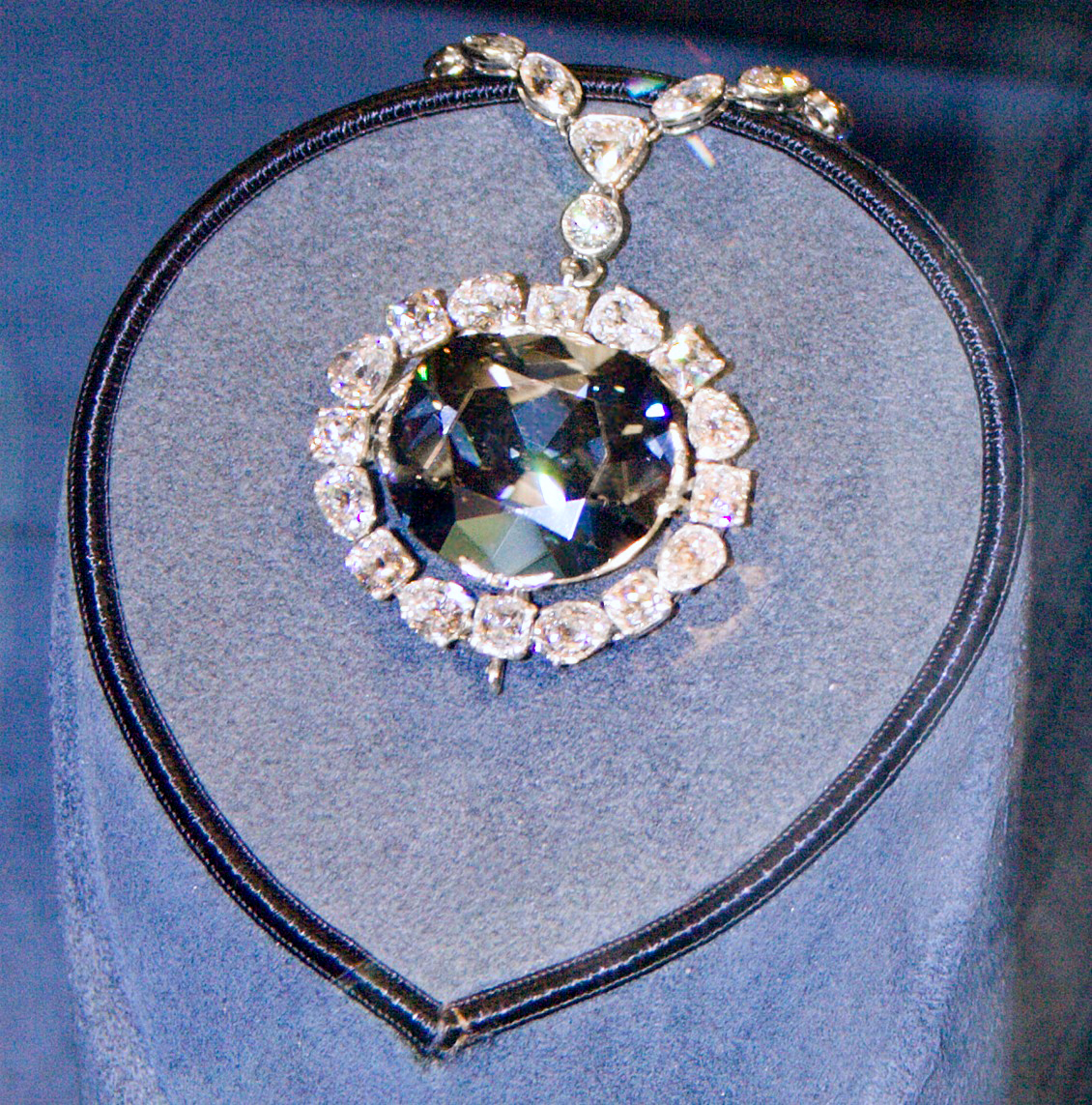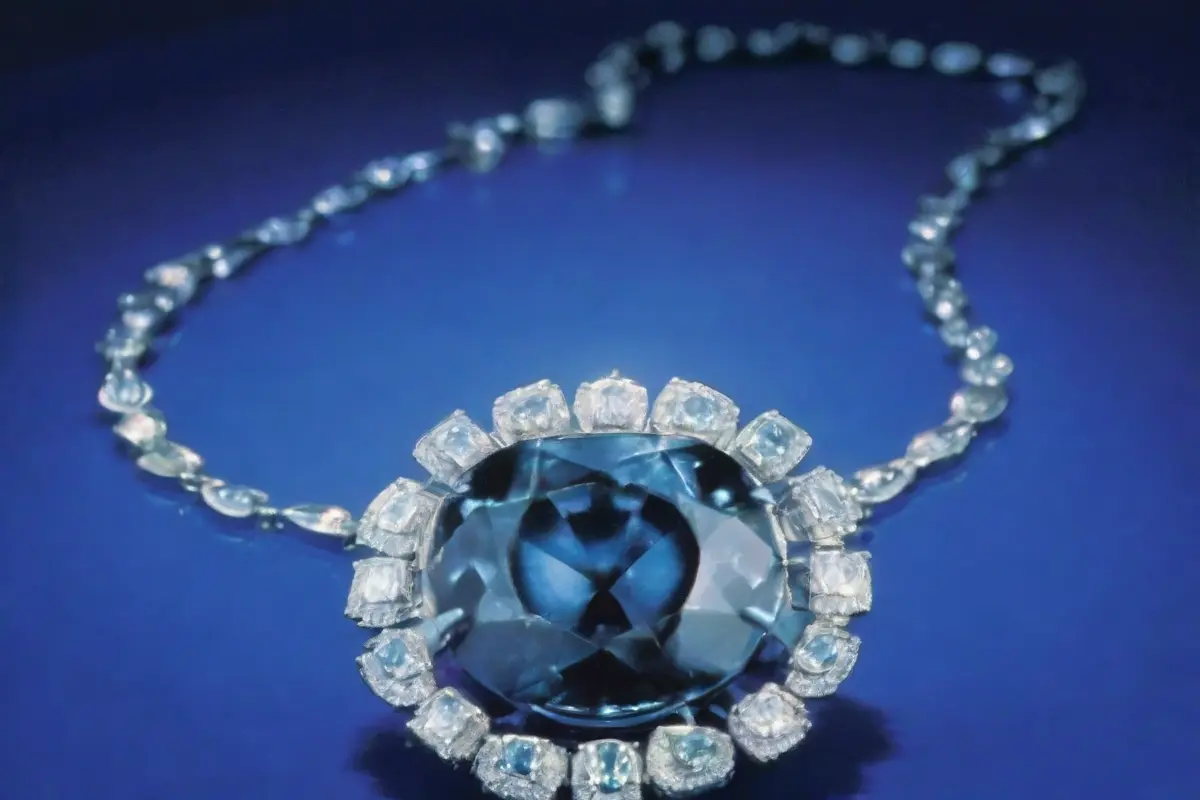Table of Contents
History of the Hope Diamond Necklace (1910)
The Hope Diamond Necklace, sometimes referred to as the “Tavernier Blue,” is one of the most famous gems in the world. Its history dates back to 1666 when it was discovered in India and sold to French merchant Jean-Baptiste Tavernier. It eventually made its way to King Louis XIV of France and remained in the French royal family until it was stolen during the French Revolution.
The diamond then passed through various owners, including British banker Henry Philip Hope, who gave it its famous name. In 1910, the Hope Diamond was set in a new necklace design and purchased by American socialite Evalyn Walsh McLean. Her ownership of the diamond was highly publicized, earning it worldwide fame and cementing its place in history.
Over the years, the Hope Diamond has been worn by numerous notable figures, including Hollywood actresses and members of the British royal family. Its journey is filled with fascinating stories and controversies, making it an intriguing subject for historians and diamond enthusiasts alike.
Today, the Hope Diamond is part of the Smithsonian Institution’s National Gem and Mineral Collection, where it is admired by visitors from around the world. Its origin, acquisition, and ownership over the years make it a truly remarkable piece of jewelry with a rich and storied past.
| Key Takeaways |
|---|
| The Hope Diamond was discovered in India in 1666 and sold to French merchant Jean-Baptiste Tavernier. |
| It passed through various owners before being purchased by American socialite Evalyn Walsh McLean in 1910. |
| The diamond’s size, blue color, and phosphorescence make it unique. |
| The Hope Diamond is associated with a legend of being cursed, though its origins are uncertain. |
| Today, it is part of the Smithsonian Institution’s National Gem and Mineral Collection. |
| The Hope Diamond Necklace inspires awe with its unique history, design, and cultural significance. |
| It holds a prominent position in the realms of gemology, fashion, and popular culture. |

By David Bjorgen – Own work, CC BY-SA 3.0, Link
The Curse of the Hope Diamond Necklace
Throughout its history, the Hope Diamond has been associated with tales of mystery and misfortune, earning it the reputation of being cursed. This famous blue diamond, which was originally discovered in India, has changed hands numerous times since it was acquired by French merchant Jean-Baptiste Tavernier in the 17th century.
Legends surrounding the curse of the Hope Diamond began with Tavernier. It is said that after he purchased the diamond, he was torn apart by wild dogs while traveling in Russia. However, this story has been debunked as Tavernier actually lived to the ripe old age of 84.
But the tale of the curse continued with King Louis XIV of France, who acquired the diamond from Tavernier. He supposedly died of gangrene after wearing the diamond in his hat, and his descendants met a similar fate. However, this curse also seems to be a myth as there is no record of the diamond being in the possession of Louis XIV.
Despite these questionable stories, the legend of the curse gained more traction when the Hope Diamond was acquired by American socialite Evalyn Walsh McLean in 1911. She faced a series of personal tragedies, including the deaths of her two children and husband. Many attributed these misfortunes to the curse of the Hope Diamond.
But the alleged curse did not stop there. Owners of the Hope Diamond continued to face misfortunes, such as illness, bankruptcy, and even untimely deaths. This only added to the intrigue and fascination surrounding the diamond’s supposed curse.
However, it’s important to note that there is no scientific evidence to support the idea of the Hope Diamond being cursed. In fact, many scientists and gemologists believe that it is simply a coincidence that the owners of this famous diamond have faced unfortunate events.
Nevertheless, the legend of the curse has only added to the allure and value of the Hope Diamond. It continues to be one of the most famous and sought-after gems in the world, proving that even a supposed curse can’t diminish its beauty and significance.
The Notable Characteristics of the Hope Diamond
The Hope Diamond is one of the most famous gems in the world, known for its exceptional size and mesmerizing blue color. But what makes this diamond so unique and special? In this section, we will explore the notable characteristics of the Hope Diamond that have captured the imagination of people for over a century.
First and foremost, the Hope Diamond is known for its massive size. Weighing in at 45.52 carats, it is one of the largest deep blue diamonds in the world. Its size alone makes it a rare and valuable gem, but it is the other qualities that truly set it apart.
One of the most intriguing aspects of the Hope Diamond is its phosphorescence. When exposed to ultraviolet light, it glows a bright red color for a period of time after the light is turned off. This phenomenon is extremely rare and adds to the mystique surrounding the diamond.
The diamond’s color is also a major reason for its fame. The deep blue hue, caused by traces of boron within the diamond, is incredibly rare and highly sought after. This color has been described as “an intense blue unlike any other gem in the Smithsonian’s collection” and is a key reason why the Hope Diamond stands out among other diamonds.
But perhaps the most intriguing characteristic of the Hope Diamond is its supposed curse. According to legend, the curse brings bad luck and tragedy to those who possess or wear the diamond. While this has been largely debunked, it adds to the allure and mystery of the diamond.
These notable characteristics – size, phosphorescence, color, and supposed curse – have made the Hope Diamond not just a piece of jewelry, but a symbol of beauty, rarity, and intrigue. Its unique features have solidified its place in history and will continue to fascinate generations to come.

The Mysteries and Myths of the Hope Diamond
The Hope Diamond has long been shrouded in mystery and controversy, with many unanswered questions surrounding its true origins and current whereabouts. One of the biggest mysteries surrounding the Hope Diamond is its exact timeline and ownership before it was acquired in 1910 by famous jeweler, Pierre Cartier. Some sources claim that the diamond was stolen from a Hindu temple in India, while others believe it was looted by French soldiers during the French Revolution. This discrepancy adds to the allure and intrigue of the diamond, making it even more mysterious.
Another controversial subject surrounding the Hope Diamond is its supposed curse. Many have attributed tragedies and misfortunes to those who have owned or come in possession of the diamond, including Marie Antoinette and members of the Hope family. This supposed curse has sparked numerous legends and stories, adding to the mystique of the diamond.
Currently, the Hope Diamond resides at the Smithsonian Institution, where it is a popular attraction for visitors. However, this has not stopped rumors and speculation about its authenticity, with some believing that the Hope Diamond on display is a replica and the real one is hidden away in a secret location. This speculation has only added to the many myths and theories surrounding the famous diamond.
Despite the many mysteries and controversies surrounding the Hope Diamond, one thing is certain: it remains one of the most valuable and famous diamonds in the world. Its unique characteristics, including its deep blue color and large size, make it a highly sought-after gem among collectors and jewelry enthusiasts. The enduring fascination with the Hope Diamond only adds to its legacy and significance in the worlds of gemology, fashion, and pop culture.
The Legacy of the Hope Diamond Necklace
The Hope Diamond Necklace holds a significant place in the worlds of gemology, fashion, and pop culture, with a lasting impact that continues to fascinate and intrigue people today.
Its sheer size, rare blue color, and remarkable history have solidified its place as one of the most famous jewels in the world. The Hope Diamond Necklace has been admired and coveted by many, and its legacy is deeply intertwined with the history of jewelry and its role in society.
In the world of gemology, the Hope Diamond Necklace stands out as a remarkable specimen. Its size and color make it a true rarity, and its association with the Smithsonian Institution only adds to its allure and prestige. Gemologists and researchers continue to study the unique characteristics of this iconic piece, fueling further interest and fascination with the necklace.
From a fashion standpoint, the Hope Diamond Necklace has inspired countless designers and looks. Its elegant and distinct design has been replicated and reimagined in various forms, cementing its place as a timeless and iconic piece of jewelry. Its notoriety has also made it a symbol of luxury and status, sought after by many who want to emulate the glamour and luxury associated with it.
Finally, in the realm of pop culture, the Hope Diamond Necklace’s legacy has been cemented through various myths, legends, and controversies. Its supposed curse has captured the imagination of people for decades, and its ownership by famous and sometimes ill-fated individuals only adds to its mystique. The necklace’s role in history, including its involvement in the French Revolution and its journeys across continents, has also contributed to its lasting impact on popular culture.
The legacy of the Hope Diamond Necklace is one that continues to captivate and fascinate people of all ages, solidifying its place as one of the most notable and influential pieces of jewelry in history.
Frequently Asked Questions (FAQ)
Where was the Hope Diamond originally discovered?
The Hope Diamond was discovered in India in 1666.
Who was the first documented owner of the Hope Diamond?
French merchant Jean-Baptiste Tavernier was the first documented owner of the Hope Diamond.
What is the Hope Diamond’s most distinctive feature?
The Hope Diamond is famed for its large size, weighing 45.52 carats, and its deep blue color caused by traces of boron.
Is there any evidence to support the legend of the Hope Diamond’s curse?
While the so-called “curse of the Hope Diamond” is a popular legend, there is no historical evidence to support its existence.
Where is the Hope Diamond currently located?
The Hope Diamond is currently part of the Smithsonian Institution’s National Gem and Mineral Collection in Washington, D.C.
